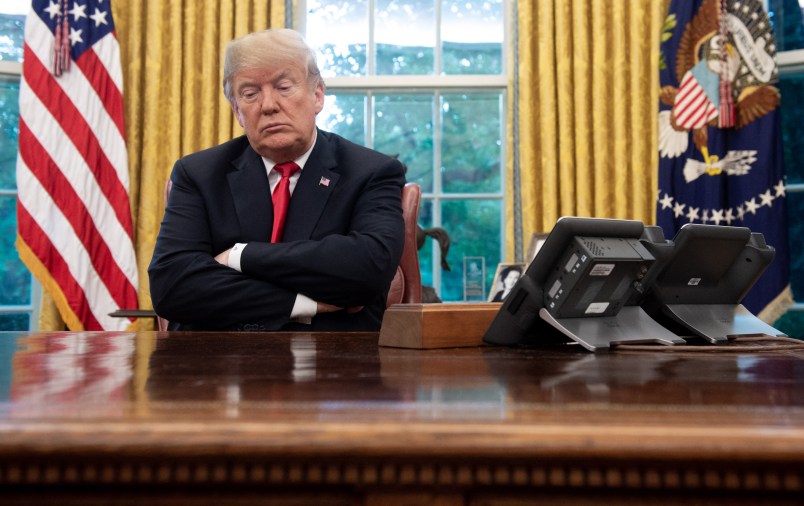One of the abiding themes of election coverage this year is that if there’s a second Trump presidency it will be more extreme, more organized and ideologically coherent and more prepared. There’s some level of psyching out the opposition going on here. But it’s still mostly correct. The major guideposts in the storyline are first that the various forces that went into Trumpism came into 2016 and 2017 not really realizing Trump was the guy. And that’s not surprising. He was Donald Trump after all, something our whole political system has difficulty remembering. Trump also staffed most of his administration with what for him were the equivalent of Hollywood leading men: ex-generals, legitimate multinational corporation CEOs, Wall Street sharks. They weren’t people Democrats like but they weren’t ideologues or even very in line with the goals Trump was pursuing by the end of his term.
The part of the story that is still too little articulated is how Trump’s personal and legal challenges galvanized and really created the whole thing. Trump’s desire for dictatorial power, to control the government in depth, to have the entire state mirror and obey his will grew from his frustration and fear of the various legal probes that stalked him. He thought when he became President that he had managed a hostile takeover of a rival company. The state and the country was his. So he could do whatever he wanted. But it didn’t turn out to be that way. And that’s how the drive to vanquish the “Deep State” was born. In other words, the kernel of Trump’s dictatorial, strongman ambitions were there from the start. But it was only the shock and ego injury of being faced with the difference between owning and governing that set him on the track, for entirely personal and self-protective reasons, of transforming the state to make it serve him in the way he wanted.
Along the way he found a community of activists, ideologues and political disappointed degenerates who were already thinking along the same lines and realized he was the vehicle to make all of it happen. Just as Trump’s mixture of insecurity, anger and grievance bonded him with small-town, white, declining America, his hunger for power and the punishment of enemies bonded him with America’s rising authoritarian movement.
The final piece of the puzzle is the way his presidency ramped up the polarization of American political and culture, all building to the epochal culture war meltdowns of COVID and the George Floyd protests in 2020. Each of these developments brings you from the half-baked and embryonic clown show autocracy of Trump’s first term to what he’s running on now.
With these points in mind there are a few pieces looking at different parts of this which have just come out. Tom Edsall at the Times looks at the network of outside pressure groups, PACs, 501c3s which make up the government in waiting. Gabriel Sherman has a much more Vanity Fairish look at the same players. Finally, there’s last night’s edition of Politico’s K Street newsletter which looks at K Street’s shift toward backing Trump after the DeSantis and Haley fantasies have been finally and thoroughly put to bed.
I should note that the usual air of skepticism should be applied to the Sherman piece in Vanity Fair — all of the usual about hyped-up quotes from interested, anonymous sources. The title is “Inside the Terrifyingly Competent Trump 2024 Campaign.” Well, okay … But let’s stipulate for starters that this is a campaign that appears yet to have set up any field offices around the country, is significantly behind Biden in fundraising, despite having the support of most of the country’s billionaires and, relatedly, is spending a very big proportion of its funds paying Trump’s legal bills and hush money — in the form of legal expenses — to many of his accomplices. This is definitely a very different operation from the 2016 three-campaign-managers, out-of-control, car-going-the-wrong-way-down-the-highway operation. Susie Wiles and Chris LaCivita should not be underestimated. At a minimum they have managed to create a space where they can manage the actual campaign while maintaining a distance from Trump’s drama and not allowing themselves to become characters in the Trump Cinematic Universe, with all that entails.
But we also need to maintain some perspective. We shouldn’t psych ourselves out. We shouldn’t find ourselves enlisting Trump’s claims that they are “terrifyingly competent” to remind us of the very real danger Trump poses to the whole American republic. In any case, the real thing to me, and where a lot of able-but-malevolent have put a lot of time into devising a comprehensive plan, is not the campaign but what starts in January 2025.


 Member Newsletter
Member Newsletter
